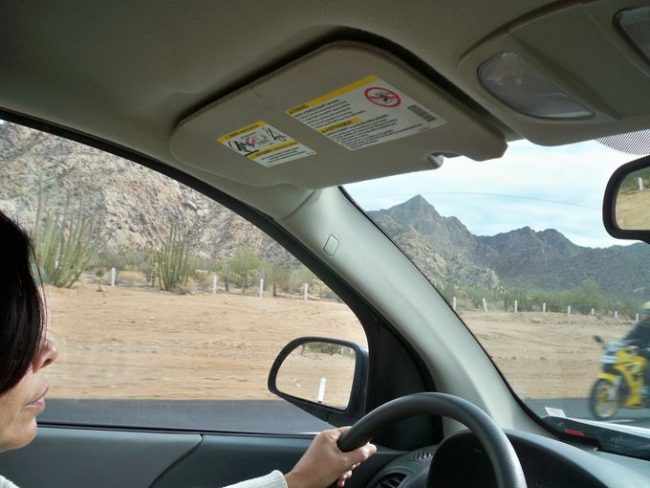To drive or not to drive, that is the question. As an expatriate U.S. citizen living just south of Tijuana for the past three years, I’ve faced challenges driving in Mexico, and also have had great times exploring the country.
If you’re intent on driving your own vehicle into Mexico, you’ll need to purchase Mexican insurance. There’s no wiggle room here. Without insurance, you’re at the mercy of the Mexican court. In the U.S., a person is innocent until proven guilty. Mexican law is based on the Napoleonic Code, where guilt prevails over presumption of innocence. If a driver from the U.S. has a traffic accident in Mexico, they need to have the means to settle any damages or injuries they’re responsible for. Insurance is a must before entering the country in your own vehicle. Thankfully it’s easy to obtain from many insurance companies for coverage as brief as one day. The insurance can be acquired online, or at numerous companies close to the border crossing on the U.S. side.
In my experience, even when both parties have insurance, minor fender benders are settled on the spot, with an exchange of a small amount of money to knock out a dent or replace a busted taillight.
Driving is on the right side of the road in Mexico, which makes initial orientation a simple affair. Traffic signs are in Spanish, so before their trip, travelers should Google Mexican road signs to brush up on the most critical of these, such as ALTO (STOP) or CURVA PELIGROSA (DANGEROUS CURVE). Mileage in Mexico is marked in kilometers, which are approximately .6 of a mile. Catch yourself before you mistakenly interpret a speed limit sign and drive almost double the limit.
One thing a traveler will notice right away is that Mexican drivers can be lax about lane changes and using turn signals. But they are especially good about respecting stop signs and uncontrolled intersections. Part of this is self-preservation, since some busy intersections don’t have traffic lights.
Road conditions are a big gripe with both visitors and residents in Mexico. Some roads are well maintained, while others might have potholes and gouges that could break an axle or flatten a tire. Roads become even iffier when venturing away from a town’s main arteries. During a rainstorm, expect flooding of roads due to a lack of proper drainage, and dirt roads that turn into mud roads. A four-wheel-drive vehicle with high ground clearance is preferable, although I’ve seen Mexican drivers do wonders with a four-cylinder beater that wouldn’t pass inspection in the States.
Driving at night in Mexico is particularly challenging. Lighting on many highways is non-existent; livestock have the habit of wandering on the road; and it’s difficult to observe hazards, such as potholes and debris.
Another thing to keep an eye out for is topes. These are Mexican speed bumps. You don’t want to hit these at full speed. There seems to be very little regulation of how high a tope should be, and I’ve seen some that are barely a ripple in a road’s surface, and others as high as curb. In my early weeks driving in Mexico, when I was behind the wheel, the Mexican passengers would scream, “Tope … tope … tope!” I didn’t know what the word meant and would hit the tope at full speed, making everyone scream for their life as we flew into the air and landed with a jolt. Not recommended.
Once a traveler has crossed the border and driven into the country, they’ll come upon military checkpoints. At the most, the soldier may ask you where you’re going and where you’re coming from. It’s a good practice to roll your back windows down when you hit a checkpoint, so they can see into your backseat.
Pemex gas stations are everywhere, and drivers rolling into one might feel as though they’ve been magically transported back to the 1950s. The attendants pump your gas, and wash your front and back windows. These workers are very poorly paid, so it’s customary to give a tip of around 10 pesos. If your route is an extensive one, it’s best to take note of where the next gas station is located, since the distance between stations can sometimes be considerable.
Drivers in Mexico will often have the choice of taking the libre (free) road or the quota (pay) road. They both have their strong points.
The libre road is the slower route, since it has more traffic lights and usually cuts through a town or city. The plus side is there’s lots of local color, small shops and intriguing restaurants.
Quota roads are better maintained and a faster route, and are often quite scenic. But they don’t give a traveler the same glimpse into daily life in Mexico, so I recommend mixing and matching on your next driving trip.
By Mark Rogers for USA Today
Source: usatoday.com





1 comment
Mark,
I can’t find much to quibble with in this article, including the “tope, tope, tope” warning. I’ve heard it from Mexican passengers as well as Gringos. Everything you wrote matched my observations, except I would have qualified the accolade for Mexican drivers’ behavior at crossroads and stop signs with a “usually”. I would only add that Mexican drivers in general drive fast, but are perhaps more courteous than neighbors from the north. I have seldom seen a middle finger in Mexico.